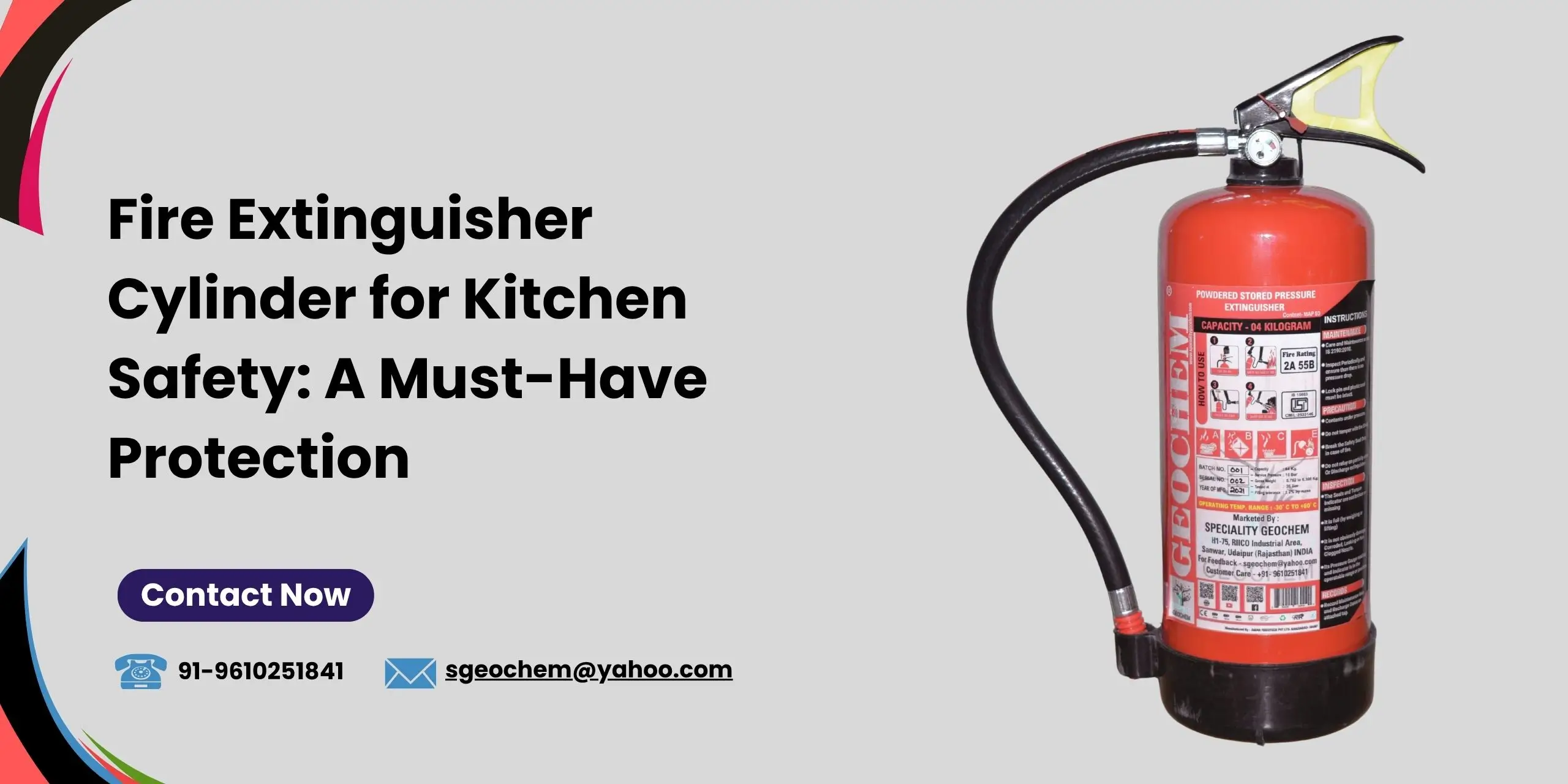Fire Extinguisher Cylinder for Kitchen Safety: The kitchen is often called the heart of the home, but it’s also the most common source of fire accidents. From cooking oil flare-ups and overheated appliances to faulty gas lines and electrical short circuits, the potential fire hazards are numerous. In such high-risk areas, having a Fire Extinguisher Cylinder for Kitchen Safety is not just a precaution—it’s a necessity. It acts as the first line of defense, providing an immediate solution before the fire spreads to other parts of your home or workplace.
Modern kitchens—whether domestic or commercial—require a reliable fire protection system that’s easy to use, quick to activate, and effective across various fire types. This is where a Fire Extinguisher Cylinder for Kitchen Safety proves its true value.
Understanding the Role of a Fire Extinguisher Cylinder in the Kitchen
A Fire Extinguisher Cylinder for Kitchen Safety is designed to quickly suppress flames caused by oil, grease, gas, or electrical faults. These cylinders contain specialized fire extinguishing agents like dry chemical powder, foam, or CO₂ that work effectively on multiple fire classes (A, B, C, and electrical).
Unlike fire blankets or water buckets that may not handle all types of fires safely, these cylinders are tested and certified to handle even the most stubborn flames within seconds. Their pressurized mechanism allows users to aim and discharge the extinguishing agent precisely, reducing fire intensity and preventing further damage.
Common Causes of Kitchen Fires
Before understanding why every kitchen needs a Fire Extinguisher Cylinder for Kitchen Safety, it’s crucial to identify common fire triggers:
- Cooking Oil and Grease Fires: Overheated oil can ignite spontaneously and spread quickly.
- Gas Leaks: Leaking LPG cylinders or loose connections can cause explosions.
- Electrical Appliances: Faulty wiring or overloaded sockets in appliances like microwaves, toasters, or blenders can spark fires.
- Cluttered Workspaces: Paper towels, plastic packaging, and fabrics near stoves catch fire easily.
- Negligence: Leaving cooking unattended remains one of the leading causes of residential fires.
Understanding these risks reinforces why every kitchen—home, hotel, or restaurant—should have a Fire Extinguisher Cylinder for Kitchen Safety installed.
Why You Need a Fire Extinguisher Cylinder for Kitchen Safety
1. Instant Response in Emergencies
During a fire, every second counts. A Fire Extinguisher Cylinder for Kitchen Safety provides an immediate response, allowing you to act before the flames spread beyond control. Its easy-to-operate nozzle and lightweight design make it usable even for individuals without technical training.
2. Effective Against Multiple Fire Classes
Kitchen fires vary in nature—some are caused by oils, others by electrical faults. A high-quality cylinder can tackle all these fire classes effectively, ensuring comprehensive protection.
3. Compact and Easy to Install
Modern Fire Extinguisher Cylinders for Kitchen Safety are compact and can be wall-mounted or stored under counters without occupying much space. They are ideal for both residential kitchens and commercial establishments.
4. Low Maintenance and Long Shelf Life
These cylinders require minimal maintenance—mostly periodic inspections to ensure the pressure gauge is in the green zone. With a shelf life of up to five years, they provide long-term protection at a minimal cost.
5. Compliance with Fire Safety Norms
Installing a Fire Extinguisher Cylinder for Kitchen Safety also ensures compliance with building and fire safety regulations, especially for commercial kitchens, cafes, and restaurants.
Types of Fire Extinguisher Cylinders Suitable for Kitchens
- Dry Chemical Powder (DCP) Cylinder:
Effective for Class A (solid), Class B (liquid), and Class C (gas) fires. It’s ideal for kitchens with LPG and oil-based risks.
- Carbon Dioxide (CO₂) Cylinder:
Suitable for electrical fires. It displaces oxygen and cools the equipment without leaving residue—perfect for kitchens with multiple appliances.
- Foam-Based Cylinder:
Excellent for flammable liquid fires (like oil or grease) as it creates a cooling barrier over the surface to prevent re-ignition.
- Wet Chemical Extinguishers:
Specially designed for cooking oil fires. They release a fine mist that cools and smothers the flame while forming a layer to prevent re-flash.
Choosing the right Fire Extinguisher Cylinder for Kitchen Safety depends on the type of fire risks present in your kitchen.
Installation Tips for Fire Extinguisher Cylinders in Kitchens
- Placement: Install near the exit or at an easily accessible location—not directly above stoves or gas cylinders.
- Height: Mount at an appropriate height (approximately 1.5 meters) for quick access.
- Label Visibility: Ensure labels indicating usage instructions are visible.
- Training: Educate family members or kitchen staff on how to operate the extinguisher correctly.
- Routine Checks: Inspect pressure gauges monthly and schedule annual maintenance by certified professionals.
Proper installation of a Fire Extinguisher Cylinder for Kitchen Safety ensures maximum effectiveness during emergencies.
Benefits of Installing a Fire Extinguisher Cylinder in Your Kitchen
- Prevents Major Property Damage: Small fires can become disasters in seconds. A quick response minimizes losses.
- Ensures Personal Safety: Protects lives by controlling fire before it spreads.
- Reduces Insurance Premiums: Many insurers offer benefits for having proper fire safety systems.
- Increases Confidence: You can cook or operate a restaurant with peace of mind knowing safety measures are in place.
- Eco-Friendly Options: Modern extinguishers use non-toxic, biodegradable agents.
Maintenance and Safety Practices
Even the best fire extinguisher won’t help if it’s non-functional. Follow these best practices:
- Check pressure levels regularly.
- Replace extinguishers immediately if damaged or expired.
- Keep the area around the extinguisher clear of obstructions.
- Conduct periodic fire drills for staff or family members.
Routine upkeep ensures your Fire Extinguisher Cylinder for Kitchen Safety performs efficiently when needed.
Fire Extinguisher Cylinder for Kitchen Safety: Conclusion
Fire prevention starts with awareness, but protection begins with preparedness. Installing a Fire Extinguisher Cylinder for Kitchen Safety is one of the simplest yet most effective ways to secure your kitchen and loved ones. Whether you’re a homeowner, restaurant manager, or food business operator, this small investment can save lives, property, and peace of mind.
At Speciality Geochem, we specialize in advanced fire safety equipment designed for modern environments. Our Fire Extinguisher Cylinders for Kitchen Safety are ISI-marked, user-friendly, and built to perform under critical conditions. From compact home cylinders to commercial-grade models, we deliver reliability that you can trust.

